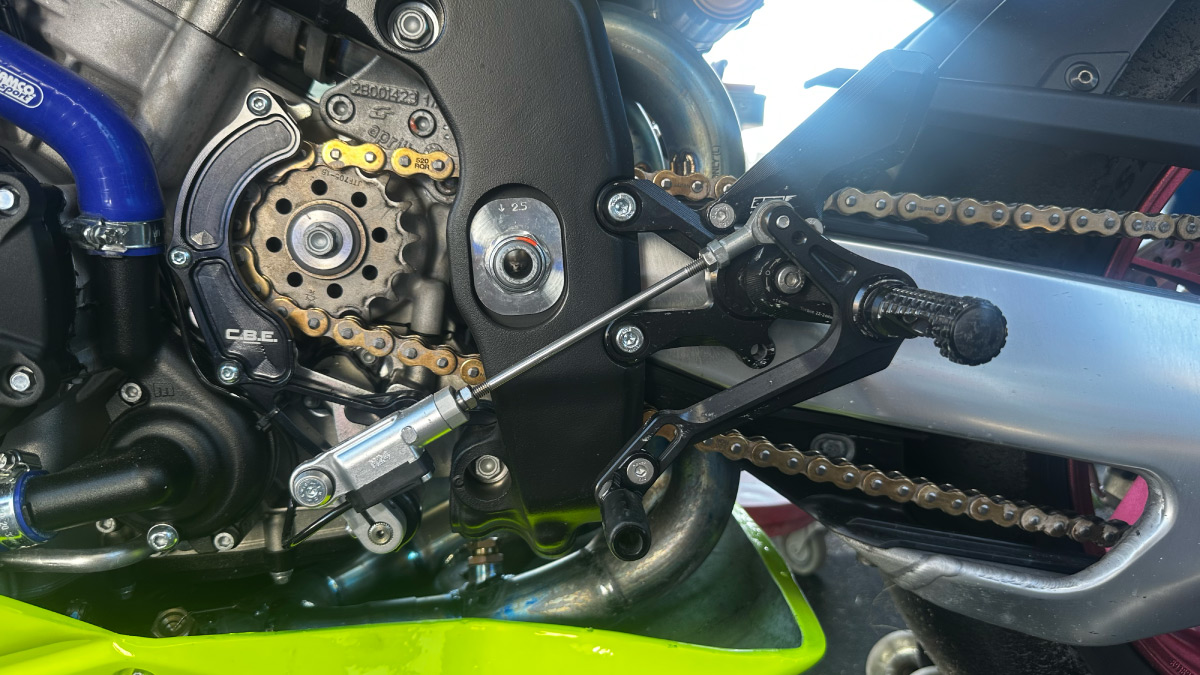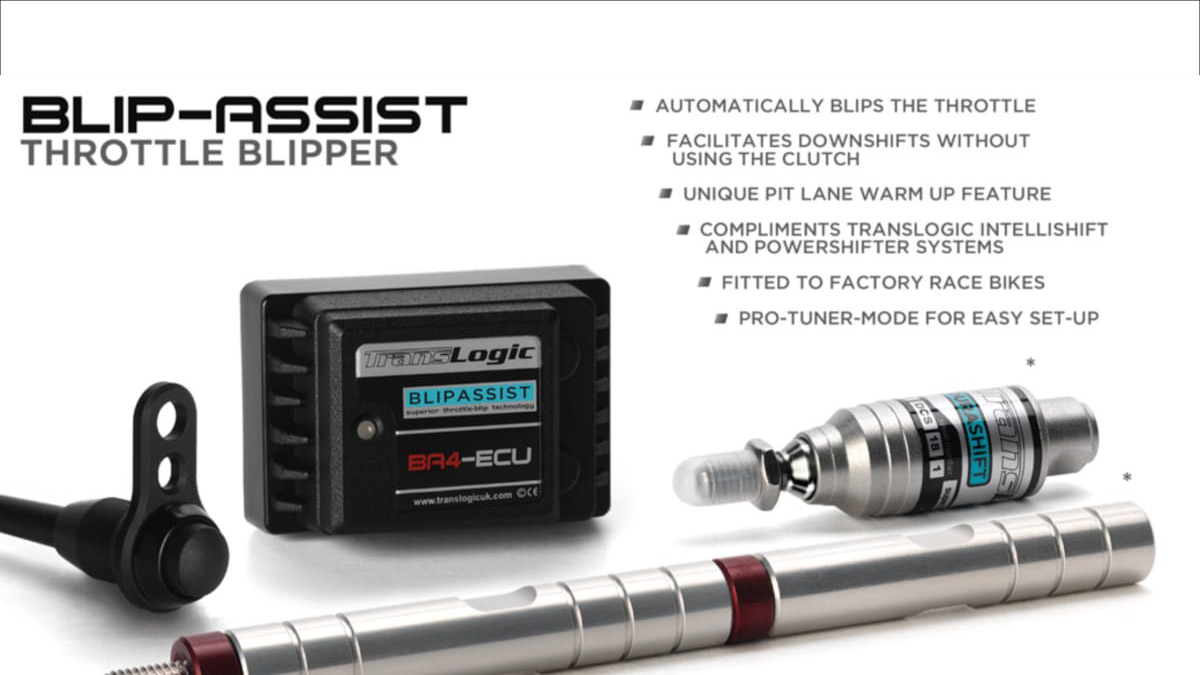THRYLLZ
Thrills we thrive on
Thrills we thrive on
‘My motorbike has a blipper.’ You’ve probably heard that before. Or a racer complaining that he or she didn’t achieve the intended lap time because the quickshifter wasn’t working. The quickshifter vs. the blipper. What are they? And what is the difference between the two? We’ll tell you more.
There was a time when this technology was only found on racing motorcycles. Nowadays, you can find them on practically every new motorcycle. They are also popular on street bikes. Even all-road motorcycles and adventure bikes have quickshifters.
Contents:
Quickshifters are now almost standard on motorcycles. But they are by no means all the same. Some motorcycles roll off the factory floor with standard basic systems, while others have full auto-blipper systems. The basic function may be the same, but the technology is different. And they can feel quite different.
First, let’s take a closer look at the quickshifter. The most standard quickshifter on modern motorcycles is a system that allows you to shift up without using the clutch.
It uses a switch in line with the rod that connects the gear lever to the gearbox. When the gear lever is pushed up (or down if you have the racing shift pattern), the switch is pressed and contact is made. A spring then adds weight to that switch. The force exerted on the lever is transferred to moving the selector in the gearbox, which selects the next gear ratio (and therefore gear).
Activating the switch briefly disconnects the spark plugs from the circuit. This temporarily interrupts the drive. It is the same process as briefly releasing the throttle while shifting to the next gear. Only it’s a lot faster. If you release the throttle long enough, the engine speed decreases and matches the speed of the gears when they are driven by the rear wheel. This causes a “floating moment”, where the teeth that engage the gears are between each other. Shifting up without a clutch takes advantage of that floating moment in the gearbox. By doing all this mechanically with the aid of a quickshifter, you can shift up without using the clutch lever.
A blipper works similarly to a quickshifter, but a blipper not only allows you to shift up without using the clutch, but also to shift down. Sometimes motorcycle manufacturers refer to a blipper as an “up and down quickshifter”. This can be confusing, as most people associate a quickshifter with a system that only allows you to shift up without using the clutch.
Similar to how upshifting without using the clutch makes use of the floating moment in the gearbox, downshifting without using the clutch requires the speed of the engine to be equal to the speed of the rear wheel.
When you release the throttle, the rear wheel drives the engine, while the speed of the rear wheel is higher than the engine speed. If you then briefly double-declutch, the engine speed briefly increases, matching the speed of the rear wheel. This again creates a “floating moment” in the gearbox. This is the moment when you can downshift without using the clutch. You can do this manually, as many older racers know. However, it requires technique and timing. It is a lot more difficult to do manually than to upshift without a clutch.
And because today’s mindset is “let’s not make it too difficult for ourselves”, the industry developed a system that does this for us. This resulted in the blipper. It does exactly the above, but mechanically. So the only thing you have to worry about is when and where you want to shift up or down. And whether you operate the gear lever correctly.

If you compare a quickshifter with a blipper, the quickshifter is essentially a one-way street, while the blipper is a two-way street. With a quickshifter, you only shift up without using the clutch, while with a blipper, you can shift up and down without using the clutch.
So, if a motorbike manufacturer claims that a motorbike has an “up and down quickshifter”, the motorbike actually has a blipper.
Quickshifters and blippers were originally used mainly on racing motorcycles, because the advantage of both is greatest when you are riding fast. Nowadays, almost every new motorcycle – both race and street bikes – comes with a quickshifter and/or blipper fitted as standard. The advantage of fast upshifting and/or downshifting at high speeds is virtually non-existent on the road, as you simply often don’t reach those speeds. Nevertheless, many road riders want a quickshifter or blipper, if only for the sound and feel they provide.
If you often ride with a passenger, it can also be a nice addition to your motorcycle. A quickshifter often allows you to shift up more smoothly, so your passenger is thrown around less. This also reduces the well-known “helmet bumping”.
One of the most popular modifications for a motorbike is installing an aftermarket quickshifter. Although installing a quickshifter incorrectly can cause serious damage to your gearbox, installing an aftermarket blipper incorrectly carries even greater risks.
As we explained earlier, a blipper requires the engine speed to match the speed of the rear wheel in order to downshift without using the clutch. To do this, the blipper “double-clutches” for you, in a mechanical way. This requires the blipper to take control of the throttle for a moment. When the system takes control, you as the rider have no control for that very brief moment.
Let that sink in for a moment. Next, we will outline the worst-case scenario you can imagine. If the blipper malfunctions, it can be fatal.

If a motorcycle comes with an OE quickshifter from the factory (even if it is an up and down quickshifter, also known as a blipper), that quickshifter is integrated into the system. This means that it is almost always part of the ECU. This means that in almost all situations, if the quickshifter malfunctions, the motorcycle will not work at all. These OE quickshifters and blippers are also tested extensively.
If you install an aftermarket blipper, it is not part of the ECU. Many blippers work by continuously analysing what the motorcyclist is doing with the throttle. This information is then sent to the ECU, which responds or does not respond, depending on the signal. If something goes wrong in that chain reaction, it is possible that the last signal the ECU receives from the blipper will remain active, even if the “downshift” action has already been completed. Imagine that signal being “throttle open”, when in fact it is not. That can cause some very scary situations.
Please don’t be stingy when installing an aftermarket blipper. That doesn’t necessarily mean you have to buy the most expensive one. There are some very good ones available at a reasonable price. But make installing the aftermarket blipper a top priority. Not a talented mechanic yourself? Then outsource it and have it done by an expert.
If you really want to do it right, buy an aftermarket blipper that has a “default” mode where it removes itself from the throttle circuit. This means that as long as you don’t shift down, the blipper is not active and cannot take control of the throttle. This prevents the blipper from giving the wrong signal at the wrong time.
These advanced blippers check themselves in milliseconds when you downshift. If the device is “happy” with how those checks went, it activates itself and participates in the throttle circuit. When that happens, a timer is also activated. If the processor crashes for some reason, the system still removes itself from the “throttle circuit” when that timer expires. This prevents a signal such as “throttle open” from ever getting stuck.
It is probably clear by now that quickshifters and blippers are quite technical devices. This makes the question “why does one quickshifter feel smoother than another” a technical question, which has to do with various factors.
Think of the mapping of the ECU, the mechanical set-up and even factors such as chain tension. These elements contribute to the feeling you experience when shifting gears. And therefore also to the feel of the quickshifter. Because the feel and operation of a quickshifter (and blippers as well) depends on so many factors, it is important to install both properly.
No quickshifter and/or blipper can perform a smooth gear change at every speed and every percentage of throttle opening. To do this properly, the system needs speed. Or at least revs.
So if you are cruising along quietly, a quickshifter and/or blipper will have difficulty doing its job. This is because your revs are low. This causes a “floating moment” that is too short and small to make a smooth gear change without using the clutch. If you do use your quickshifter, the gear change will always feel rough and stiff. And remember: in many cases, the rule is “if it doesn’t go smoothly, something is wrong”. And in this case, it doesn’t do your gearbox any good either. So don’t use your quickshifter and/or blipper when you’re cruising around or driving at relatively low revs on the motorway.
Ultimately, both quickshifters and blippers are designed to provide convenience and peace of mind when shifting at high speeds and revs.

You should be able to install a quickshifter on any motorbike. The rod must be long (or short, depending on how you look at it) enough to give the quickshifter unit enough space. Other than that, there are few limitations. A blipper is a different story. To install a blipper, your motorbike must have ride-by-wire. This means that the system in the motorbike uses sensors and the ECU for the throttle opening. As a result, many older motorbikes are not compatible with modern blippers.
Nowadays, both quickshifters and blippers can be found on almost every new motorbike. The difference between a quickshifter and a blipper is that a quickshifter only allows you to shift up without pulling the clutch lever. A blipper allows you to shift up and down without using the clutch. You will experience the greatest benefits of these systems on track. Or at least when riding at high speeds. But a quickshifter can also provide a lot of comfort (and fun) on a street bike. Just be careful when installing an aftermarket quickshifter and/or blipper. And use them wisely. Using a quickshifter or blipper while riding at low speeds does more harm than good to your motorbike.
Oh, and don’t forget your shift pattern. Some quickshifters and/or blippers require you to choose the right module for your chosen shift pattern. Quickshifter vs blipper… which one will you go for?
We use cookies to improve your experience on our site. By using our site, you consent to cookies.
Websites store cookies to enhance functionality and personalise your experience. You can manage your preferences, but blocking some cookies may impact site performance and services.
Essential cookies enable basic functions and are necessary for the proper function of the website.